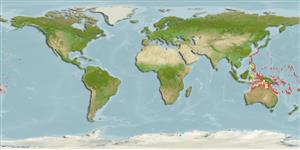Common names from other countries
Environment: milieu / climate zone / depth range / distribution range
Écologie
marin récifal; profondeur 1 - 34 m (Ref. 11890), usually 1 - 12 m (Ref. 90102). Tropical; 30°N - 24°S, 120°E - 170°W (Ref. 74933)
Indo-Pacific: Moluccas and Philippines to Samoa and Tonga, north to the Ryukyu Islands, south to southern Great Barrier Reef; Mariana and Caroline Islands in Micronesia.
Taille / Poids / Âge
Maturity: Lm ? range ? - ? cm
Max length : 10.0 cm TL mâle / non sexé; (Ref. 9710); common length : 7.7 cm SL mâle / non sexé; (Ref. 37816)
Description synthétique
Clés d'identification | Morphologie | Morphométrie
Épines dorsales (Total) : 8; Rayons mous dorsaux (Total) : 9; Épines anales: 2; Rayons mous anaux: 8. Characterized by having dorsal fin rays VII-I, 9; anal fin rays II,8; pectoral fin rays 13; pelvic fin rays I, 5; pored lateral line scales 24; predorsal scales 3-4; circumpeduncular scales 12 (Ref. 93839); color is coppery or silvery with saddle or bar across the caudal peduncle and a wedge-shaped bar below the eye. Similar to A. fuscus but usually has fewer gill rakers (25-27 versus 28-30). Leading edge of ventral fin clearly pale-blue (Ref. 48635); characterized further by grey caudal peduncle with broad dark bar at base; pale grey at night; greatest depth of body 2.2-2.6 in SL (Ref. 90102).
Occur in outer reef slopes generally at depths below 30 m (Ref. 1602). Nocturnal species (Ref. 7300). Solitary or in small groups (Ref 90102).
Life cycle and mating behavior
Maturities | Reproduction | Spawnings | Egg(s) | Fecundities | Larves
Mouthbrooders (Ref. 240). Distinct pairing during courtship and spawning (Ref. 205).
Myers, R.F., 1991. Micronesian reef fishes. Second Ed. Coral Graphics, Barrigada, Guam. 298 p. (Ref. 1602)
Statut dans la liste rouge de l'IUCN (Ref. 130435)
CITES (Ref. 128078)
Not Evaluated
Menace pour l'homme
Harmless
Utilisations par l'homme
Outils
Articles particuliers
Télécharger en XML
Sources Internet
Estimates based on models
Preferred temperature (Ref.
115969): 25.9 - 29.3, mean 28.6 (based on 1393 cells).
Phylogenetic diversity index (Ref.
82804): PD
50 = 0.5020 [Uniqueness, from 0.5 = low to 2.0 = high].
Bayesian length-weight: a=0.01445 (0.00860 - 0.02429), b=3.09 (2.95 - 3.23), in cm Total Length, based on LWR estimates for this species & (Sub)family-body (Ref.
93245).
Niveau trophique (Ref.
69278): 3.3 ±0.3 se; based on size and trophs of closest relatives
Résilience (Ref.
120179): Haut, temps minimum de doublement de population inférieur à 15 mois (Preliminary K or Fecundity.).
Fishing Vulnerability (Ref.
59153): Low vulnerability (10 of 100).
